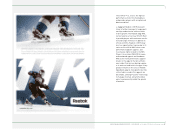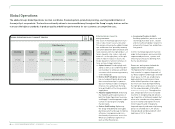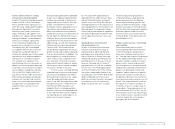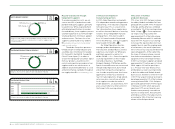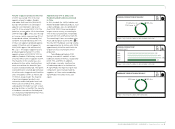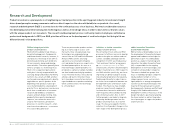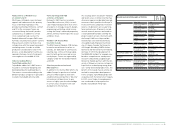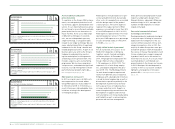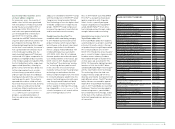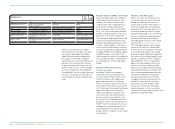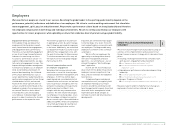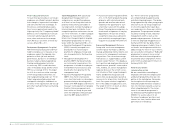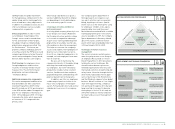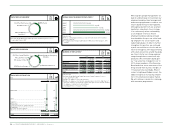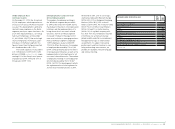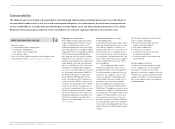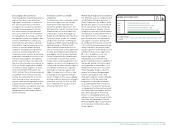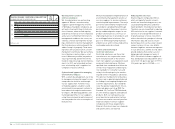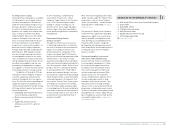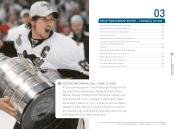Reebok 2009 Annual Report Download - page 101
Download and view the complete annual report
Please find page 101 of the 2009 Reebok annual report below. You can navigate through the pages in the report by either clicking on the pages listed below, or by using the keyword search tool below to find specific information within the annual report.
GROUP MANAGEMENT REPORT – OUR GROUP Employees 97
Employees
We know that our people are crucial to our success. Becoming the global leader in the sporting goods industry depends on the
performance, potential, enthusiasm and dedication of our employees. We strive to create a working environment that stimulates
team engagement, spirit, passion and achievement. We promote a performance culture based on strong leadership and therefore
link employee compensation to both Group and individual achievements. We aim to continuously develop our employees with
opportunities for career progression, while upholding a culture that celebrates diversity and encourages global mobility.
Engagement drives performance
At the adidas Group, we believe that
employee satisfaction drives commit-
ment, commitment drives engagement,
and engagement drives performance.
Therefore, we have defined engagement
as one of our Group’s key performance
indicators for measuring our efforts
to sustain a “performance culture”. To
capture employee perceptions, we regu-
larly carry out engagement surveys. This
frequent dialogue enables management
to evaluate our progress as an employer
while also providing a framework for
external benchmarking. Our 2008 and
2009 surveys identified areas such as
career opportunities, leadership and rec-
ognition where employees feel our Group
could do better. In 2009, we invested
heavily in the follow-up work after our
surveys around the world. Based on the
feedback received in the survey process,
we created “Result-to-Action teams”
in each business unit, encouraging
our employees to develop targets and
projects in order to enhance the Group’s
performance in the respective areas.
This bottom-up approach should result
in appropriate actions by senior manage-
ment to improve perceived discrepancies
in the future. Additionally, we committed
our department heads to assume respon-
sibility for their engagement score, with
the goal of increasing it in future surveys.
To continue momentum in this area, we
will launch our first truly global engage-
ment survey in 2010.
Internal communication crucial
for employee engagement
We believe that two-way internal com-
munication is crucial for fostering open
collaboration between management and
employees. In 2009, we further devel-
oped, aligned and consolidated internal
communication tools across our business
units. In particular, throughout 2009, we
worked on reshaping our Group intranet
platform, basing it on Web 2.0 tech-
nologies with two-way communication
channels. The new intranet encourages
our employees to exchange ideas, share
their knowledge, collaborate as well as
discuss current topics. We established an
adidas Group Wiki, where every employee
can actively participate by creating new
articles and editing all other articles.
In parallel, we switched all major pages
to internal blogs, for a faster, more effi-
cient and participatory conversation with
our employees. The blogs enable every
employee to comment on the communi-
cated topics.
We also offer our employees the
opportunity to exchange ideas directly
with senior management and raise
questions – also anonymously – via our
intranet through our “Ask the Manage-
ment” application.
In 2010, we will also introduce an
ideas forum for the adidas Group, where
employees receive recognition for top
ideas, and are involved in the implemen-
tation process.
Complementing our web-based
communication tools, we regularly hold
all-employee meetings at our major
locations around the world where staff
have the opportunity to openly share their
views with senior management includ-
ing the Executive Board and gain an
overview of current and future business
developments.
THREE-PILLAR HUMAN RESOURCES
STRATEGY
We strive to have the right team in place by focusing our
activities on the implementation and execution of our
Group’s human resources strategy, which is based on three
pillars:
Creating a working environment that stimulates team
spirit, passion, engagement and achievement
see “Engagement drives performance”, p. 97
see “Internal communication crucial for employee
engagement”, p. 97
Expanding our performance culture based upon strong
leadership
see “Fit for today and tomorrow”, p. 98
see “Performance-driven remuneration system”, p. 98
Being an “Employer of Choice”
see “Creating an attractive and diverse work environment”, p. 99
Measures taken in order to implement our strategy are
explained in the text sections referred to above.


